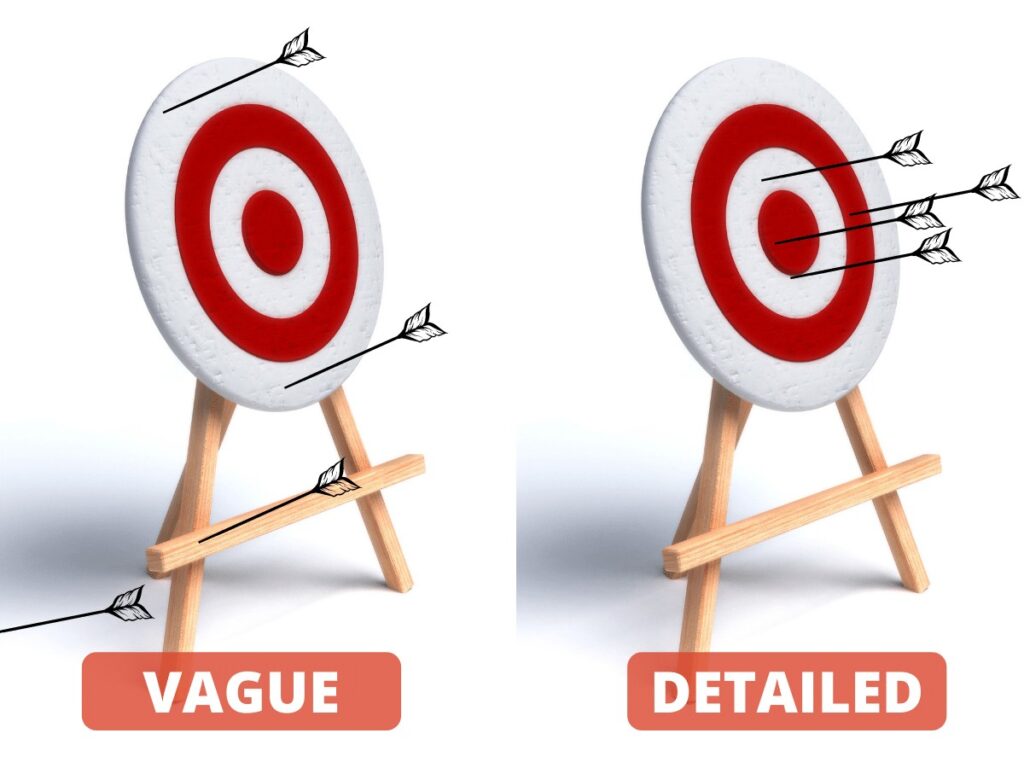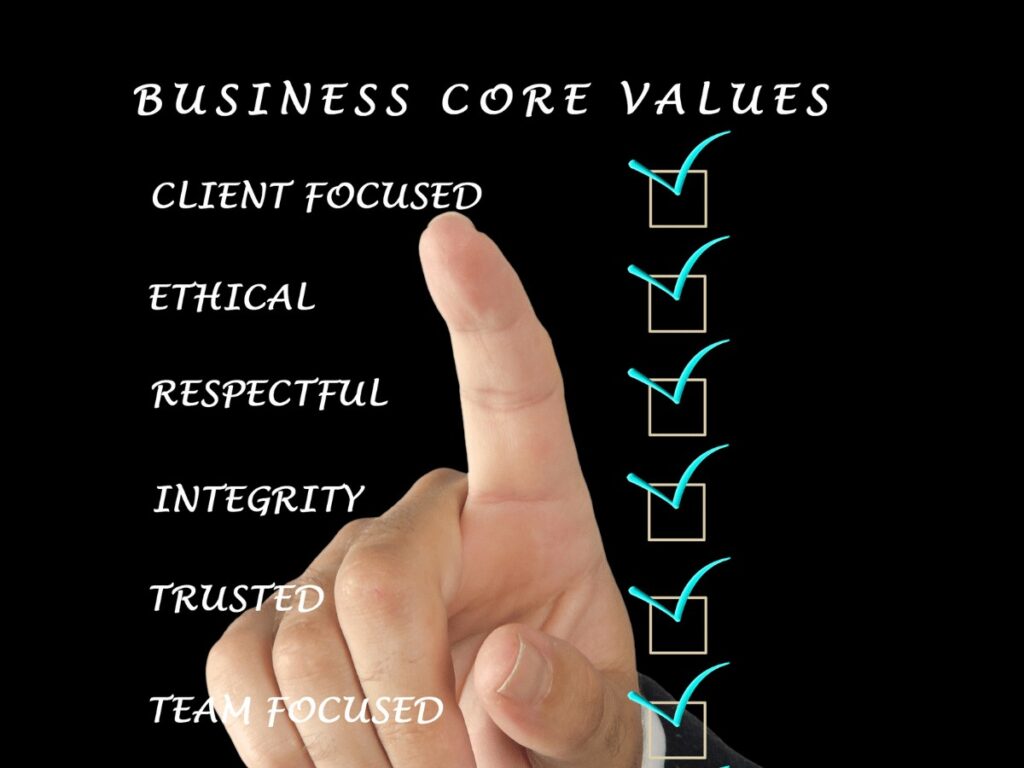Mission, Vision, and Values Template and Examples

Many of us use the mission and vision interchangeably. However, the two statements are distinctly different. The Mission Statement focuses on where the organization is right now. In contrast, the Vision Statement creates a picture of the organization’s future.
The values of your organization, though, are probably more important than even the vision and mission. These values are the criteria that you use to make decisions within your organization.
If you wanted to take a trip in a car, the vision would be the destination. The mission would be the vehicle. Finally, the values would be the directions or the road map to get there. So, you can see that each of the three is important to get to the end goal. Without the destination, we have no way of knowing if we are moving toward our goal. In addition, without the right vehicle, the journey will be more challenging. Then, of course, without a map, your journey can have a lot of wasted effort.
Create a Valuable Vision Statement First When You Use the Mission, Vision, Values Template.
Before working on the mission and values, start with creating a great vision statement. It is easier to do everything else if you have a crystal clear purpose of the organization and a picture of the destination.
First, though, let’s talk about why you need a great vision for the future. In every organization’s life cycle (every person as well,) there are two forces at play. The past is like a tree. The past includes all of an organization’s history including both successes and failures. The older the organization, the more rings that it has and the deeper the roots. Picture your organization attached to this tree with bungee cords.
As a manager of the organization, you may try to make positive changes. Realize, though, that you are in a constant battle with the past. Your team has certain habits that have been developed over time. The organization also has processes in place that make change more difficult as well. So when a new manager comes in with lots of enthusiasm, the group may experience a quick burst of growth. However, the further the group moves from the status quo, the more difficult the journey.
Once the effort diminishes, the organization will likely move backward — into the past.
Your vision statement, though, adds a bungee cord that pulls you into the future. The stronger the vision, the more sustainable energy pulling you forward. The past will have less hold on you. So, start your strategic planning process by creating an inspirational vision for the future.
When Creating Your Vision Statement DON’T Try to Do It By Yourself.
Remember that your team has ingrained habits. Your organization also has ingrained processes. If you just show up one day and say, “Here is our new vision,” you will meet resistance. You will have much better success if you pull your key stakeholders together to make the vision more global.
Send out an agenda for the meeting ahead of time to give your team a chance to think about it. You might ask them a question like, “If we were successful beyond our wildest dreams, what would our organization look like?” Then, when you start the meeting write every idea on a flip chart. Brainstorm until you get 10 to 20 short phrase answers.
Set a time limit. Your team will take as much time as you give them to complete the vision statement. My suggestion would be to limit the time to just 10 to 20 minutes.
Once you have a number of responses, end the meeting. Then, take the best ideas and create a simple and cohesive vision statement for the group. If you are from my generation, think of the last minute of The Breakfast Club. The diverse group of detention attendees each got input on the essay. Your team will move toward the vision faster if they help create it.
This can be a very useful exercise to create a strong foundation for your organization. It can also be a good educational experience for the leader. (You may find out things you didn’t know about your team members in the process.)
By the way, if you are looking for a template for a Personal Vision Statement, click here. We have a separate blog post for that type of vision statement.
Make Your Vision Statement as Specific as Possible.

For instance, here is Amazon’s vision statement: “Our vision is to be earth’s most customer-centric company; to build a place where people can come to find and discover anything they might want to buy online.”
I know what you are thinking… “Sure, with all the success that Amazon has had, it is easy for them to think big like that.” However, this was the vision that Jeff Bezos had in 1997 when Amazon went public. That vision was created when they were just selling books online and trying to compete with Barnes & Noble.
In archery, if you aim for the target and miss, you will miss the target. However, if you aim for the bullseye and miss, you still hit the target. So, avoid vague superlatives. Most vision (and mission) statements use words like “a market leader” or “provide quality products.” By the way, here is one of the worst examples. “Be the global leader in customer value.” When you read it, there is no way to even know what industry the company is in. (It is big engines, by the way.)
Here are some of my favorite examples of vision statements:
- Land O’Lakes Vision — Our vision is to be one of the best food and agricultural companies in the world by being: Our customers’ first choice; Our employees’ first choice; Responsible to our owners; and A leader in our communities.
- Microsoft (at its founding) — A computer on every desk and in every home.
- LinkedIn — Create economic opportunity for every member of the global workforce.
Next, Create a List of Values that Set Your Organization Apart from Other Organizations.

I found out how important this written list of values is just recently. Years ago, my team and I created a list of five values that sets us apart from our competition. (By the way, if you want to see them they are listed at Leader’s Institute ® Values.)
At the top of our list is Responsiveness. From the early days of the company, we realized that when potential customers have a problem, they want a solution right now. The second was Quality. Frankly, we charge a premium price for our services. As a result, our customers expect the highest quality. They expect perfection. The third was Cooperation. Our customers want the process to be easy. The last two are Initiative and Continuous Improvement. Our team members have to be able to solve problems without having to slow down the solution process. In addition, we know that as good as we are today, if we are not improving the processes, we will be left behind.
These high standards help us create common goals as a team.
How Creating that Value List Paid Off in a Huge Way.
A couple of years ago, we set an audacious goal for growth. We wanted to quadruple revenue in less than five years. After setting the goal, I had a quick realization. Some of my team members were going to be instrumental in the growth. Others, however, may actually harm the growth process. I also knew that we were going to need to bring in a significant number of new team members as we progressed toward the goal.
So I and my top two executives created a little worksheet with the five core values listed on it. Then, we added the names of each of our team members. Finally, we gave each a score based on the way that we perceived each team member in each area. For instance, my score for initiative was a 10 out of 10. Apparently, my strength is taking initiative. However, I scored a 3 out of 10 in cooperation. (Not my strength.)
We did that for each team member. We realized very quickly that some of our hiring decisions may have hampered growth. In the heat of the moment, we needed skilled people. So, when we found people with the needed skills who would work for what we would pay them, we hired them. We don’t do that anymore. Now, we look first at how each applicant scores in each of our core values. This has helped us make much better hiring decisions.
Here Is a List of Potential Values that You Can Use as a Starting Point.
|
|
|
This list is not comprehensive. It is there to give you some ideas. By the way, your core values don’t have to be just single words. Google’s core values are pretty fun to look at. They created ten core values. Here is a couple of them. “Fast is better than slow.” “You can be serious without a suit.” “Great just isn’t good enough.”
Now that You Have a Great Vision and Core Values, The Mission Statement Is Much Easier to Create.

All morning, I got the team to, in great detail, by the way, tell me the functions of the company. It turns out, their purpose for existing was related to boxes, but their customers didn’t really want the boxes. They wanted the results that the boxes gave them. The customers were looking for ways to ship their products from one location to another with little or no damage. Once they realized this, a whole new world of possibilities opened up.
Their salespeople were no longer just talking to customers about how to increase the number of boxes per order. The conversations changed to ways that they could help the customers better protect their inventory.
Your Mission Is Not What You Do. Your Mission Is the Result that You Help Your Customers Create.
We have a number of different companies under The Leaders Institute ® banner. For instance, our Fearless Presentations ® group offers presentation skills training. Our mission though isn’t something vague like, “We offer world-class public speaking classes.” Instead, we focus on the result. “We help people conquer the fear of public speaking in just a couple of days.”
The difference between the mission statement and the vision statement is that we are CURRENTLY helping people reduce public speaking fear. We are known around the world for that.
In our team building company, our mission isn’t “To provide the best team building activities.” Instead, “We help our customers make meetings more fun and valuable.” It is what we do, and our customers love that we do that.
So, when you create your mission statement, first, take a look at your vision statement and values. Then, ask yourself, “How exactly do we do that? What result do our customers receive?”
The answer is not your product or service. That result, however, is likely to be a great mission statement for you!
Examples of Mission Statements
Each of these organizations’ mission statements clearly explain what they do. You can use these as a template for your own company’s mission if you like.
- National Geographic – We support a diverse, international community of changemakers — National Geographic Explorers — who use the power of science, exploration, education, and storytelling to illuminate and protect the wonder of our world.
- Slack – Slack brings all your team’s communication together, giving everyone a shared workspace where conversations are organized and accessible.
- MailChimp – Send better e-mail. We help millions of customers to find their audience, engage their clients, and build their brand.
- Spotify – Our mission is to unlock the potential of human creativity – by giving a million creative artists the opportunity to live off their art and billions of fans the opportunity to enjoy and be inspired by it.
- Swarovski – Swarovski adds sparkle to everyday life with high-quality products and services that exceed our customers’ desires. We inspire our colleagues with innovation and reward their achievements while striving to expand our market leadership.
For additional company’s mission statements, see 101 Incredible Mission Statements.
Use the Template Below to Create a Mission and Vision Statement as Well as List Your Core Values.
Use the Vision, Mission, and Values Template below to create an inspiring statement and explain your organization’s purpose. Start with an effective vision statement. Next, use the dropdown lists to create value statements for your organization. Finally, focus on the mission of the organization last. (It will be easier that way.)

